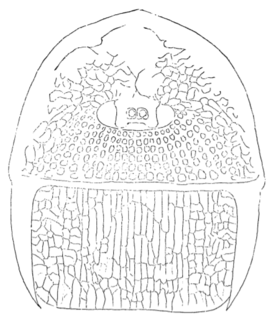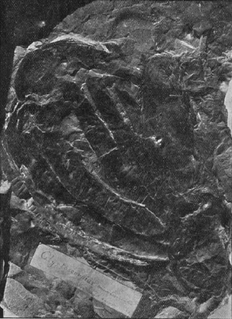 W
WAdelophthalmus is a genus of eurypterid, an extinct group of aquatic arthropods. Fossils of Adelophthalmus have been discovered in deposits ranging in age from the Early Devonian to the Early Permian, which makes it the longest lived of all known eurypterid genera, with a total temporal range of over 120 million years. Adelopthtalmus was the final genus of the Eurypterina suborder of eurypterids and consisted the only known genus of swimming eurypterids from the Middle Devonian until its extinction during the Permian, after which the few surviving eurypterids were all walking forms of the suborder Stylonurina.
 W
WArthropleura is a genus of extinct millipede arthropods that lived in what is now northeastern North America and Scotland around 345 to 295 million years ago, from the Viséan stage of the lower Carboniferous Period to the Asselian stage of the lower Permian Period. The larger species of the genus are the largest known land invertebrates of all time, and would have had few, if any, predators.
 W
WEophrynidae is a family of the extinct arachnid order Trigonotarbida. Eophrynids lived during the Carboniferous period in what is now modern Europe and North America. The family is probably found within the "eophrynid assemblage" clade:.
 W
WEophrynus is an extinct genus of arachnids from the extinct order Trigonotarbida, which lived during the Late Carboniferous period in Europe. The genus was first described in 1871 by Henry Woodward (geologist). The name comes from Eo, meaning 'dawn', and Phrynus, an extant genus of whip spider.
 W
WEophrynus prestvicii is an extinct species of arachnid belonging to the order Trigonotarbida.
 W
WHibbertopterus is a genus of eurypterid, a group of extinct aquatic arthropods. Fossils of Hibbertopterus have been discovered in deposits ranging from the Devonian period in Belgium, Scotland and the United States to the Carboniferous period in Scotland, Ireland, the Czech Republic and South Africa. The type species, H. scouleri, was first named as a species of the significantly different Eurypterus by Samuel Hibbert in 1836. The generic name Hibbertopterus, coined more than a century later, combines his name and the Greek word πτερόν (pteron) meaning "wing".
 W
WIdmonarachne is an extinct genus of arachnids, containing one species, Idmonarachne brasieri. It is related to uraraneids and spiders.
 W
WMycterops is a genus of prehistoric eurypterid of the family Mycteroptidae. Mycterops lived during the Carboniferous period in Europe and North America.
 W
WNyranius is a genus of fossil millipedes from the Upper Carboniferous (Westphalian) of Europe, containing the species N. costulatus and N. tabulatus. Specimens reach up to 10mm in width, and are covered in fine grooves, similar to other members of the extinct Xyloiuloidea.
 W
WPlesiosiro is an extinct arachnid genus known exclusively from only nine specimens from the Upper Carboniferous of Coseley, Staffordshire, United Kingdom. The genus is monotypic, represented only by the species Plesiosiro madeleyi described by Reginald Innes Pocock in his important 1911 monograph on British Carboniferous arachnids. It is the only known member of the order Haptopoda. The original locality from which these fossils originate is no longer available thus it is unclear whether any further examples will be found.
 W
WThe order Trigonotarbida is a group of extinct arachnids whose fossil record extends from the late Silurian to the early Permian. These animals are known from several localities in Europe and North America, as well as a single record from Argentina. Trigonotarbids can be envisaged as spider-like arachnids, but without silk-producing spinnerets. They ranged in size from a few millimetres to a few centimetres in body length and had segmented abdomens, with the tergites across the backs of the animals' abdomens, which were characteristically divided into three or five separate plates. Probably living as predators on other arthropods, some later trigonotarbid species were quite heavily armoured and protected themselves with spines and tubercles. About seventy species are currently known, with most fossils originating from the Carboniferous coal measures. In July 2014 scientists used computer graphics to re-create a possible walking gait for the animal. However, a subsequent biomechanical analysis proved the proposed coordination pattern as largely non-physiological.
 W
WVernonopterus is a genus of eurypterid, a group of extinct aquatic arthropods. Fossils of Vernonopterus have been discovered in deposits of the Carboniferous period in Scotland. The name of the genus derives from the location where the only known fossil has been discovered, Mount Vernon near Airdrie in Lanarkshire, Scotland. A single species of Vernonopterus is recognized, V. minutisculptus, based on fragmentary fossilized tergites, segments on the upper side of the abdomen. The species name minutisculptus refers to the ornamentation of scales that covers the entirety of the preserved parts of the eurypterid.
 W
WXyloiuloidea is an extinct superfamily of millipedes that existed from the Lower Devonian through the Upper Pennsylvanian period in Europe and North America.